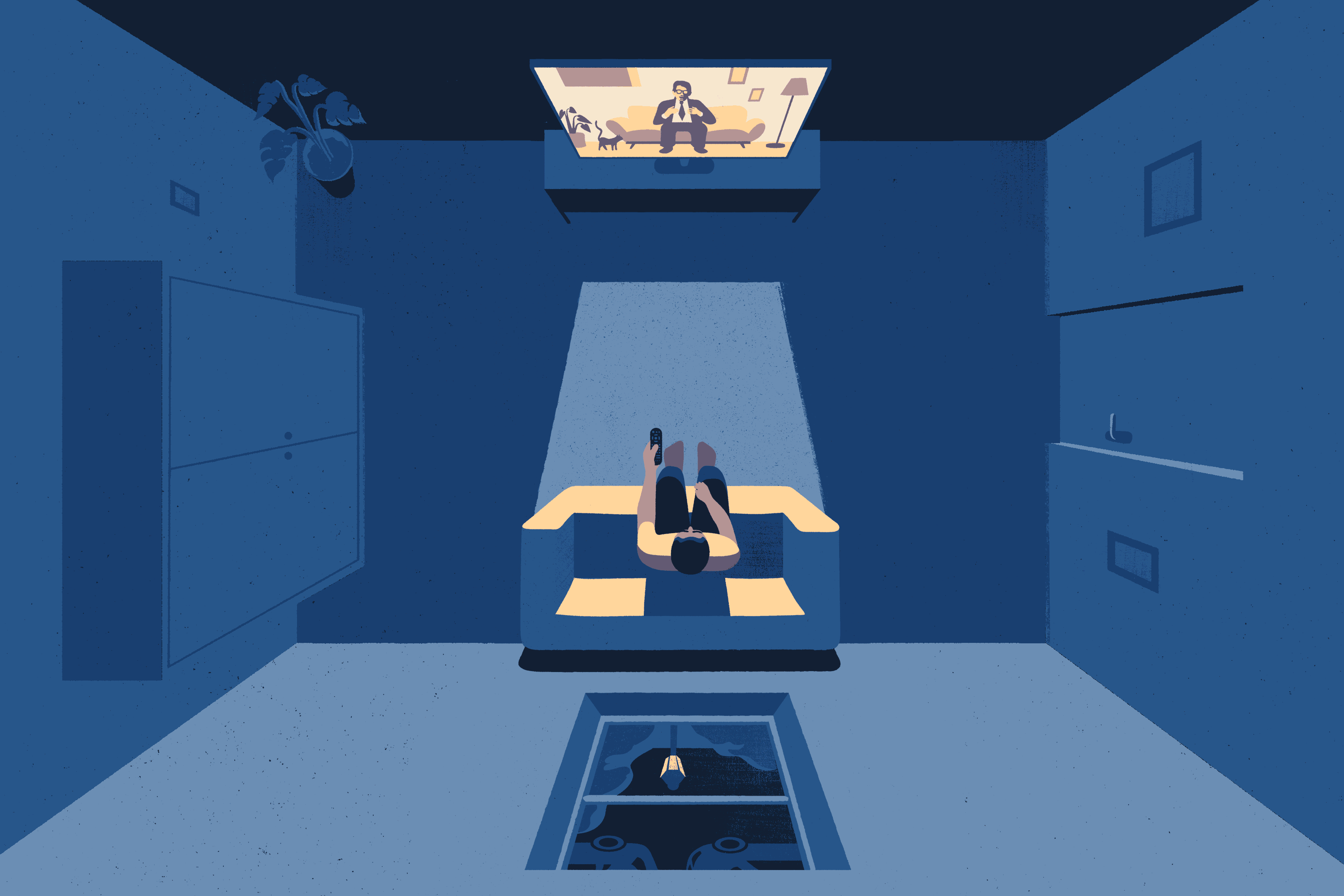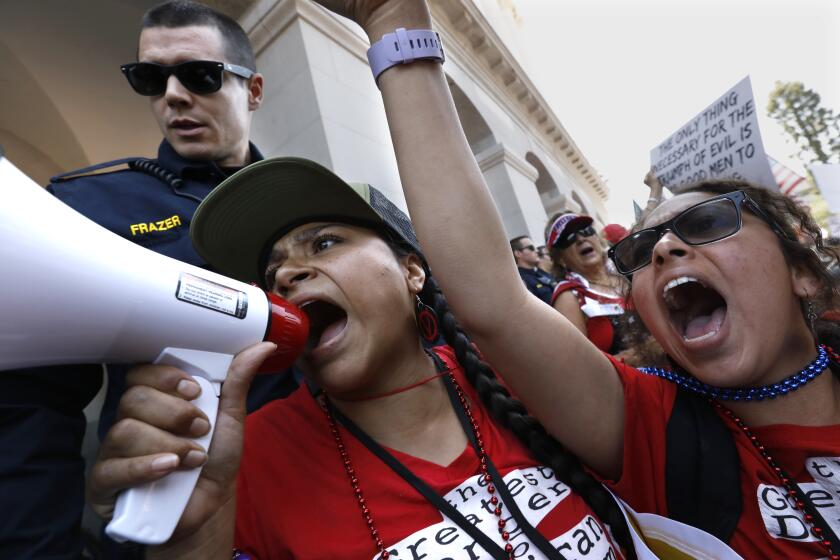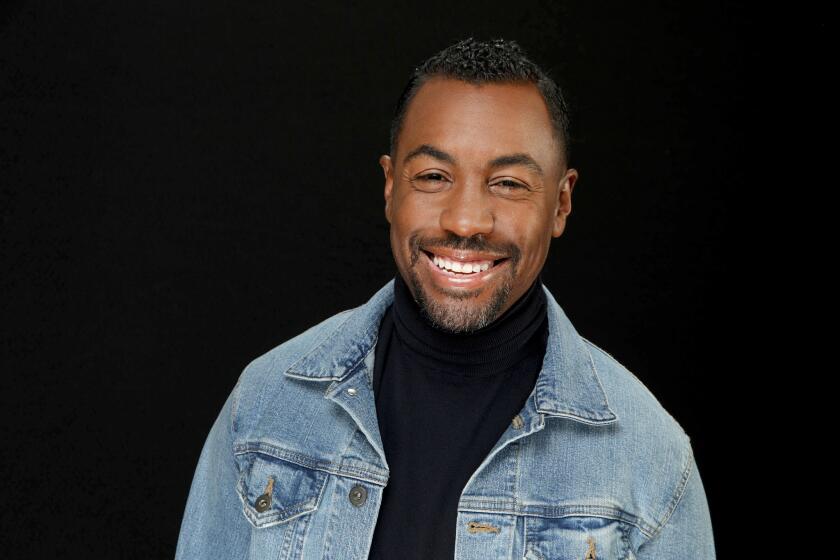- Share via
Seth Meyers has been in late night TV for almost 20 years, long enough to make comedy through several national crises. In fact, his “Saturday Night Live” debut was on the show’s first episode after 9/11.
But the COVID-19 pandemic has presented all new challenges for the comedian and the team at “Late Night,” including producer Mike Shoemaker and writer Amber Ruffin. The show last taped a complete episode at 30 Rockefeller Plaza in New York City on March 11 and has been producing full at-home editions since March 30.
It’s been a learning process for everyone, with more than a few heart-stopping moments along the way thanks to frequent technological hiccups and the occasional stray wasp.
Meyers is working out of an attic that normally serves as his sons’ playroom and is multitasking as host, cameraman, sound guy and stylist. Ruffin, used to batting around ideas in the office shared by the “Late Night” writing staff, is coming up with jokes from the kitchen table in her Manhattan apartment, while Shoemaker is at home in Westchester County, dashing off memos from the place in his home with the most reliable WiFi, his bedroom.
And they’re all making a show without the energy and motivational feedback from fans in the studio, for as long as it might take.
“We’re trying to still connect to our audience, and it means as much to us as it does to them,” Meyers says, “but it’s not normal and we don’t know when it will be back to normal.”
Here’s a look at a day in the life of “Late Night” at home.
A mode of communication designed to get us to stay home, often skewered as the “boob tube” or “idiot box,” TV kept its lights on as others flickered out.
7:30 a.m.: Shoemaker brews his morning coffee. His days in quarantine begin and end much earlier than they did in the Before Times. After writing his daily staff memo, he looks for the first draft of “A Closer Look,” which usually comes in overnight from writer Sal Gentile. The segment , which is a deep dive into a news-making subject, has become Meyers’ signature.
9 (or so): Meyers heads to the attic to start work for the day after a few hours of childcare, which he divides with his wife. “My kids know I leave every day in the city to go and do a show, but now that I’m doing it in the attic I feel like they’re judging me. ‘You’ve been able to do this from an attic? You’re not a big shot,’” he says.
Shoemaker sends Meyers scripts for what they call the “detritus” — the short intros, goodnights, transitions and promos — which Meyers loads into a teleprompter app.
10:40: After he and head writer Alex Baze review the “Closer Look” script, Meyers reads through the latest draft on a Zoom call with Shoemaker and other key writers and producers. It’s a chance to share any final ideas or notes. Once the call is over, Gentile gets a final copy to Meyers in about 30 minutes.
From Joe Biden’s video dispatches to at-home news anchors, TV’s post-COVID future is already here.
11 (roughly): Ruffin, a writer on “Late Night” since 2014, hasn’t quite adjusted to her new reality. “I still have margarita mix left on my desk that I didn’t take home because I didn’t take this seriously. It went really quickly from ‘We’re doing a show’ to ‘Who knows when we will be back in this building again?’” she says.
Ruffin is used to getting to the office at 9:30 a.m., but now that she’s working from home — sharing precious space with her husband, a painter — her routine is much more fluid. Instead of collaborating in person, she’ll email a draft of a sketch to fellow writer Jenny Hagel or John Lutz, then get their notes, and that’s it. “It’s a lot more streamlined.” The writers gather each Friday on Zoom to read the sketches they’ve come up with. It’s a meeting that happened before the coronavirus (when it was on Thursdays), but now “there’s a lot more weight on it because it’s a good percentage of all your social interactions,” Ruffin says.
Other days, Ruffin might be filming a sketch to be broadcast that night. She appears in some of the show’s most popular recurring segments, including “Jokes Seth Can’t Tell” and “Amber Says What.” About a half-hour before she starts recording, she’ll check in with key crew members over Zoom to make sure everything is set up properly — a painstaking process. “It’s so funny to see these people who just quietly assemble literally everything we’ve ever needed, trying to talk you through adjusting the dimmer in your frigging kitchen,” says Ruffin, who also spends time managing drop-offs and pickups of equipment, costumes and wigs.
Prominent creators such as Kenya Barris, Gloria Calderon Kellett and John Ridley discuss the effects of the coronavirus crisis on TV diversity.
Even though Ruffin has had a few recording snafus, she thinks filming sketches at home has at least one benefit: “You are not about to fail real hard in front of 200 people. If it stinks, it will stink privately.”
Producing the show remotely, without an audience rendering instant judgment, has enabled more offbeat humor, according to Meyers: “Now ultimately the only taste we have to run it past is our own, and we can let the audience judge us silently from a distance.”
Normally, “Late Night” has a daily dress rehearsal at 4:30 p.m., where jokes are tested in front of 40 or so tourists plucked from the lobby of 30 Rock. It’s a process that usually weeds out “any real esoterica or odd jokes that only make us laugh,” Shoemaker says, because “an audience that we pull that are half Swedish don’t know the references. Now the dumbest stuff makes it.” The show’s new domestic setting has inspired jokes, including a running gag about the copy of the novel “The Thorn Birds” in Meyers’ attic.
“I feel like it’s a great time to take chances,” says Ruffin. “All it has to be is funny to Amber Mildred Ruffin and Seth Adam Meyers. There used to be a real huge barrier between me and national television. Now it’s just Seth.”
11:15 or so: Meyers gets on Zoom again “so the hair and makeup can take a look at me and make sure I don’t look too much like a weird ghost,” he says. “In the early days it was like that scene in ‘The Twilight Zone’ episode when the girl takes off her bandages and everyone screams. But we’re getting better.”
With more than 40 series in production at one time, no network has had to adapt to the coronavirus outbreak quite like reality TV powerhouse Bravo.
Meyers’ sons often move the equipment around, so before he begins taping each day he has to reset his camera (actually an iPad mounted in a tripod) with remote help from director Alex Vietmeier. “I was a TV/film major in college and I worked at ‘Saturday Night Live.’ But I learned nothing! Literally, couldn’t have learned less about TV production if I tried,” Meyers joked.
11:45-ish: More or less alone in his attic, Meyers starts taping the show. First up is the “detritus,” then it’s time to tackle “A Closer Look,” which he calls “the longest, most arduous part of my day.” The host is used to reading off cue cards handwritten by Wally Feresten but now has to rely on a teleprompter app that, unlike Feresten, isn’t customized to the rhythm and speed of his jokes. “It’s really given me a lack of faith in AI and in the future, which I guess is good. I’ve started to think computers won’t take over.”
In addition to technical challenges, Meyers has to contend with occasional interruptions by his kids. “Today [my wife and I] agreed that because we were both working the boys could entertain themselves. And the older one just wandered up here and I couldn’t get him out,” Meyers says, so his son ended up in that night’s episode.
For Meyers, used to performing in front of nearly 200 people a night — typically none of whom are related to him — telling jokes into a void has also been an adjustment. “It turns out maybe a lot of us who do this for a living need the adulation of strangers,” he says.
‘Parks and Recreation,’ ‘The Blacklist’ and other TV series have adapted to life under the coronavirus. But what will scripted TV look like after it?
1:30: Unless there’s major late-breaking news, Meyers will record his monologue — written by Baze and a team of monologue writers — around this time.
Typically the writers would be polishing the monologue up until the show begins taping around 6:30 p.m. But during quarantine, when the headlines are all about one thing, “2 o’clock news and 6 o’clock news” aren’t so different, says Meyers.
“Normally, we would barely have read the monologue jokes by this time,” says Shoemaker, but in the new normal nearly everything happens hours earlier because the “Late Night” editors are also working from home “and everything is going over the same internet everyone is watching ‘Ozark’ on so it’s jammed.”
2-3: Meyers interviews guests over Zoom. This is the part of the day that gives Shoemaker “minor heart attacks all the time” because of the high potential for glitches. “You’ll be watching a really good interview and then it freezes. It happens about half the time,” he says. “We long to be back in the studio just to have wired connections.”
We asked networks and streaming platforms of all stripes to tell us what we can expect to see on TV during our coronavirus summer. Here’s what they told us.
Between 3 and 4.: Meyers wraps for the day, a good three to four hours earlier than his usual schedule. The days are shorter, but the stress of juggling writing and performing with, well, everything, takes its toll.
“There’s just this thin veneer of panic on top of everything. There’s so many things I don’t want to be doing that I’m doing, from light to sound to wardrobe and makeup, and you realize what a gift it is to work at places like ‘SNL’ and ‘Late Night’ where you’re just surrounded by the best people in the world and that just allows you to focus on things like writing and performance. It does take up mental energy to get all the other parts of the show right. It’s exhausting. Once 4 o’clock comes, I just ache.”
Meyers tries to get his kids to bed early, especially now that his NBC colleague Jimmy Fallon is broadcasting from his home in the Hamptons, which is outfitted with an elaborate indoor slide. “The thing we’re trying to avoid at all costs is our kids watching ‘The Tonight Show’ and finding out about this slide.”
6 or so: Shoemaker wraps for the day when he knows the episode has been delivered at the right length. With no commute or live taping to oversee, he’s “home” hours earlier than normal, even if the work never really ends. “The texting goes on all night,” he says, “because there’s always something.”
More to Read
The complete guide to home viewing
Get Screen Gab for everything about the TV shows and streaming movies everyone’s talking about.
You may occasionally receive promotional content from the Los Angeles Times.









